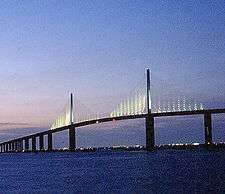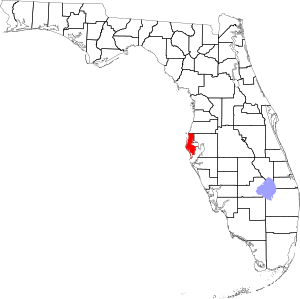Dunedin, Florida
Dunedin /dəˈniːdɪn/ is a city in Pinellas County, Florida, United States. The name comes from Dùn Èideann, the Scottish Gaelic name for Edinburgh, the capital of Scotland. Dunedin is the 5th largest city in Pinellas County. The population was 35,321 at the 2010 census.[5]
Dunedin, Florida | |
|---|---|
| City of Dunedin | |
 Seal | |
 Location in Pinellas County and the state of Florida | |
| Coordinates: 28°1′31″N 82°46′31″W | |
| Country | United States |
| State | Florida |
| County | Pinellas |
| Settled | 1852 |
| Incorporated (town) | 1899 |
| Incorporated (city) | 1925 |
| Government | |
| • Type | Commission–Manager |
| Area | |
| • Total | 22.94 sq mi (59.41 km2) |
| • Land | 10.41 sq mi (26.96 km2) |
| • Water | 12.53 sq mi (32.46 km2) |
| Elevation | 30 ft (9 m) |
| Population (2010) | |
| • Total | 35,321 |
| • Estimate (2019)[2] | 36,537 |
| • Density | 3,514.94/sq mi (1,357.07/km2) |
| Time zone | UTC-5 (Eastern (EST)) |
| • Summer (DST) | UTC-4 (EDT) |
| ZIP codes | 34697-34698 |
| Area code(s) | 727 |
| FIPS code | 12-18575[3] |
| GNIS feature ID | 0281860[4] |
| Website | www |
Dunedin is home to several beaches, including Dunedin Causeway, Honeymoon Island, and Caladesi Island State Park, which is consistently rated among the best beaches in the world.[6] Dunedin is one of the few open waterfront communities from Sarasota to Cedar Key where buildings do not completely obscure the view of the Intracoastal Waterway and the Gulf of Mexico beyond; a 1-mile (1.6 km) stretch of Edgewater Drive (also known as Alternate US 19) south of downtown offers views of St. Joseph Sound, Clearwater Beach, and Caladesi Island. Downtown Clearwater and Clearwater Beach are a 6-mile (10 km) drive south on Edgewater.
The downtown business district is notable for its absence of large commercial signage, corporate franchise restaurants or chain retail stores. The Pinellas Trail, a 39-mile-long (63 km) bicycle and pedestrian trail that traverses all of Pinellas County, bisects downtown Dunedin. A large portion of the trail lies on the former roadbed of the Orange Belt Railway, the first railroad in Pinellas County, which arrived in 1888.
Since 1977, Dunedin is the spring training home of the Toronto Blue Jays, as well as the class-A Dunedin Blue Jays of the Florida State League. Dunedin is one of the smallest communities used by Major League spring training teams, although surrounded by a large metropolitan area. TD Ballpark is situated next to the Dunedin Public Library a few blocks south of downtown on Douglas Avenue, and is just two blocks east of Edgewater Drive. The stadium was built as a replacement to Grant Field, the Blue Jays' first spring training ball park. The library was founded in 1895 and is the oldest public library in Pinellas County.[7]
Until early 2005, Dunedin was the home of Nielsen Media Research's production operations. The city is home to multiple breweries including Dunedin Brewery, Florida's oldest microbrewery.
Geography
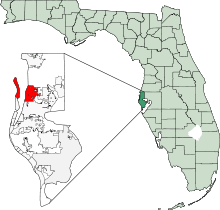
Dunedin is located at 28°01′31″N 82°46′31″W, which is the approximate geographic center of the city. The middle of downtown (intersection of Main Street and Douglas Avenue) is located at 28°00′42″N 82°47′16″W.[8]
According to the United States Census Bureau, the city has a total area of 28.2 square miles (73 km2). 10.4 square miles (27 km2) of it is land and 17.8 square miles (46 km2) of it (63.20%) is water.
Dunedin is bordered by the city of Clearwater to the south and east, the Gulf of Mexico to the west, and by Palm Harbor (an unincorporated community of Pinellas County) to the north.
Neighborhoods
- Braemoor
- Osprey Place
- Stirling Heights
- Spanish Acres
- Spanish Place
- Lake Haven
- Virginia Crossing
- Waterford Crossing
- Fairway Estates
- Curlew Landings
- New Athens City
- Lake Highlander
- Weathersfield
- Dunedin Mobile Manor
- Spring Lakes
- Spring Lake South
- Golden Acres
- Ranchwood Estates
- Amberlea
- Spanish Trails
Demographics
| Historical population | |||
|---|---|---|---|
| Census | Pop. | %± | |
| 1900 | 113 | — | |
| 1910 | 256 | 126.5% | |
| 1920 | 642 | 150.8% | |
| 1930 | 1,435 | 123.5% | |
| 1940 | 1,758 | 22.5% | |
| 1950 | 3,202 | 82.1% | |
| 1960 | 8,444 | 163.7% | |
| 1970 | 17,639 | 108.9% | |
| 1980 | 30,203 | 71.2% | |
| 1990 | 34,012 | 12.6% | |
| 2000 | 35,691 | 4.9% | |
| 2010 | 35,321 | −1.0% | |
| Est. 2019 | 36,537 | [2] | 3.4% |
| U.S. Decennial Census[9] | |||
As of the census[3] of 2000, there were 35,691 people, 17,258 households, and 9,543 families residing in the city. The population density was 3,438.1 inhabitants per square mile (1,327.6 per km2). There were 19,952 housing units at an average density of 1,922.0 per square mile (742.1 per km2). The racial makeup of the city was 94.88% White, 2.00% African American, 0.22% Native American, 1.11% Asian, 0.03% Pacific Islander, 0.64% from other races, and 1.11% from two or more races. Hispanic or Latino of any race were 3.34% of the population.
There were 17,258 households, out of which 18.2% had children under the age of 18 living with them, 43.9% were married couples living together, 8.8% had a female householder with no husband present, and 44.7% were non-families. 37.9% of all households were made up of individuals, and 20.6% had someone living alone who was 65 years of age or older. The average household size was 2.01 and the average family size was 2.63.
In the city, the population was spread out, with 15.6% under the age of 18, 5.4% from 18 to 24, 24.5% from 25 to 44, 24.6% from 45 to 64, and 29.9% who were 65 years of age or older. The median age was 48 years. For every 100 females, there were 84.4 males. For every 100 females age 18 and over, there were 81.3 males.
The median income for a household in the city was $34,813, and the median income for a family was $47,620. Males had a median income of $31,876 versus $27,072 for females. The per capita income for the city was $23,460. About 4.8% of families and 8.2% of the population were below the poverty line, including 8.8% of those under age 18 and 7.5% of those age 65 or over.
Education
Pinellas County Schools operates the public school system.
Within the city limits of Dunedin, there are four public elementary schools, one middle school and one high school:
- Curtis Fundamental Elementary School c 1976
- Dunedin Elementary School
- Garrison-Jones Elementary School
- San Jose Elementary School c 1958
- Dunedin Highland Middle School
- Dunedin High School c 1961
There are two charter schools (Athenian Academy of Pinellas (Greek immersion school founded 2000) and Academie DaVinci (elementary and middle school)), two private schools (Anchor Academy (Grades 6 to 12) and Dunedin Academy(K to Grade 12)) and one Catholic school, Our Lady of Lourdes (founded 1962 for K to Grade 8).
Until July 2006, Dunedin was the home of the main campus of Schiller International University.[10] The university main campus is now in Largo.[11]
86.6% of the city's 36,000 have a high school diploma, 22.4% bachelor's degree or higher, 7.1% graduate degree.
Economy
Dunedin previously hosted an office of Nielsen Media Research. In 2003 the company consolidated its employees in a new complex in Oldsmar, Florida, with workers from Dunedin and other areas in Pinellas County moving into the Oldsmar Building.[12]
TD Ballpark and Englebert Complex are used by the Dunedin Blue Jays and spring training facilities for the Toronto Blue Jays since 1977. TD Ballpark was built on the former Grant Field c. 1930.
Controversy
Dunedin has been accused of draconian fines towards its residents. In one case, it is suing a former resident over a hundred thousand dollars for yard and swimming pool maintenance.[13] There are cases where the city has charged tens of thousands of dollars over uncut grass or aesthetic city code violations.[14] The city has a $250 to $500 per day accruing violation policy per city code § 22-79(d).[15] "In 5½ years, the city has collected nearly $3.6 million in fines, sometimes tens of thousands at a time, for violating laws that prohibit grasses taller than 10 inches, recreational vehicles parked on streets at certain hours or sidings and bricks that don't match."[13]
Transportation
Dunedin's major highway US Route 19 Alternate connects the city with the rest of Florida, while Main Street and Pinellas County Road 1 provides local connections.
The closest airport is St. Petersburg-Clearwater International Airport located southeast of Dunedin.
History
Richard L. Garrison was the first person given a land grant in Dunedin in 1852. The settlement was originally named Jonesboro by George Jones, the owner of the area mercantile. Two Scotsmen, J.O. Douglas and James Somerville, later named the settlement Dunedin after applying for the first post office in northern Pinellas County. The name is taken from Scottish Gaelic Dùn Èideann, the Scottish Gaelic for Edinburgh. With a dock built to accommodate larger sailing vessels, Dunedin became an important trading center and at one time it had the largest fleet of sailing vessels in the state.
Dunedin became incorporated as a town in 1899 in part as a response to numerous complaints about pigs running rampant in the settlement, leading to a still-standing ban on livestock within city limits. By 1913, the town had a population of only 350.[16] It became incorporated as the City of Dunedin in 1925.[17]
Dunedin and the Roebling Alligator
During and shortly before World War II the Food Machinery Corporation factory in Dunedin (now demolished) was the primary site for the production of the Landing Vehicle Tracked developed by FMC Dunedin's Engineers and Donald Roebling of Clearwater from Roebling's own Alligator.[18][19]
Initial training[20] on the LVTs was done at the FMC factory under the auspices of the first Amphibian Tractor School, led by Major William W. Davies.[21] Until barracks and maintenance facilities were completed, the school and its students were housed in the Hotel Dunedin. After training, the Marines from the first Amphibian Tractor School were sent to flesh out the 1st Amphibian Tractor Battalion, which has served with distinction since. In mid-1944, the Marine unit in Dunedin was transferred to Camp Pendleton, California.[22]
Historic buildings
Located on Edgewater Drive, the Fenway Hotel is a historic hotel (c. 1927) that saw many famous guests throughout its lifetime.
Other historic structures in Dunedin:[23]
- Andrews Memorial Chapel built in 1888
- J. O. Douglas House built 1880
- Willis S. Blatchley House built 1916
- Dunedin Golf Club 11th Hole Bridge c. 1926
Traditions

Sister city to Stirling, Scotland, Dunedin has maintained and embraced its Scottish roots. Once a year, Scottish clans descend upon the city for the Dunedin Highland Games. Both Dunedin High School and Dunedin Highland Middle School have competition-level pipe and drum bands. The high school's marching band is known as the Scottish Highlander Band, and both teen and adult members make up the City of Dunedin Pipe Band.
In addition to the Highland Games, Dunedin hosts many other annual festivals. The most popular among these is Dunedin's Mardi Gras celebration, during which thousands of visitors descend on the small town.
Youth organizations
- Boy Scouts Troop 10-Chartered by First Presbyterian Church of Dunedin
- Cub Scouts Pack 10 - Chartered by First Presbyterian Church of Dunedin[24]
- Boy Scouts Troop 422 - Chartered by Our Lady of Lourdes Catholic Church
- Cub Scouts Pack 422 - Chartered by Our Lady of Lourdes Catholic Church[25]
Local government
Administration
The City of Dunedin currently operates under a nonpartisan commissioner-manager form of government. The commission comprises four commissioners and a mayor, who are elected by the registered voters under a staggered system.[26]
The chief executive officer, known as the city manager, oversees the ten departments and the annual budget.
Currently, the Dunedin City Commission is made up of Mayor Julie Ward Bujalski, Vice-mayor Heather Gracy, Commissioner Maureen "Moe" Freaney, Commissioner Deborah Kynes, and Commissioner Jeff Gow. The city manager is Jennifer Bramley.
The city government is made up of ten departments with various divisions and sections. The departments are Administration, Human Resources, Information Services, Public Works, Parks & Recreation, Fire, Library, Community Services, Economical Development, Planning/Development and Finance. The Community Redevelopment Agency (CRA) oversees downtown projects and the needs of downtown Dunedin merchants and tourism.
Dunedin boasts an extensive Volunteer Services section, and enables all citizens the chance to have their opinions expressed and tended to. Currently, there are 39 boards and committees that serve as advisory groups to the city manager and the City Commission.[27]
Law enforcement and fire
Dunedin Fire Department has 48 firefighters split into 16 members over three shifts.[28] The department has 3 fire stations proving fire protection for Dunedin.
Pinellas County Sheriff Office's North District Patrol provides law enforcement for Dunedin.
Recreation
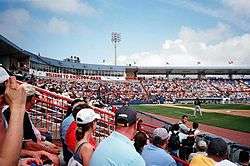
The city of Dunedin contains a Parks & Recreation Department, which provides low-cost recreation programming to the city's residents. The city operates four recreation facilities, each one designed to provide resources for a specific age group.
In 2007, Dunedin opened its newest and largest recreation facility, the Dunedin Community Center at a cost of just over $10 million. The project was mostly paid for by the "Penny for Pinellas" tax. The St. Petersburg Times wrote that Marston "figured that since the county needs recreation programs of its own and the city needs a new community center, why not ask the county to pay for the project in exchange for access to the new facility." Marston's proposal marked a turning point for the city as it saved Dunedin taxpayers millions, and allowed Dunedin officials to replenish vital strategic reserves. The center features classrooms / multi-purpose rooms, dance and exercise rooms, fitness center, gymnasium, kids area, gaming room, library, playground, rental facility, stage.[29]
The Dunedin Fine Art Center (DFAC), opened in 1975 has grown to be one of the most renowned centers for visual art instruction and exhibition in the southeastern United States. At nearly 40,000 sq. ft., DFAC houses 5 galleries, 15 studio classrooms, the Gallery Gift Shop, the Palm Cafe and the DLM Children's ART Museum. Tampa Bay Times writer Lennie Bennett says that DFAC is “the artistic equivalent of a village square,” offering quality experiences to people of all ages.
Other recreation facilities includes:
- Martin Luther King, Jr. Recreation Center - classrooms, game room, gymnasium, outdoor basketball courts, picnic area, playground, rental space, skate park, teen room
- Hale Seniors Activity Center - ballroom event rooms, classrooms, meeting rooms, exercise room, computer room, game room, gift shop, rental rooms[30]
- Dunedin Nature Center
- Highlander Pool Complex/Kiwanis Spraygrounds - outdoor pool open from April to September
- Dunedin Country Club - a semi-private golf course with memberships available and the course is open to the public. The course was deeded to the city of Dunedin for recreational purposes in 1930 by the Contract Investment Company.
The city has a large athletic base, with community soccer, baseball, hockey, and softball teams. Dunedin reflected the Gaelic origins of its name by playing host to a short lived American shinty club, Dunedin Camanachd, in the mid-2000s.
In 2011 the City of Dunedin passed ordinance 2011-04 which authorized the street-legal use of golf carts across approximately 60% of the city.[31]
City owned parks include:
- Achieva Paw Park
- Amberlea Park and Playground
- Dunedin Recreation Center and Playground
- Eagle Scout Park
- Edgewater Park and Playground - waterfront park with marinas and kayak launch area
- Elizabeth Skinner-Jackson Park and Playground - features a basketball court
- Hammock Park and Playground - located next to baseball fields used by Greater Dunedin Little League
- Happy Tails Dog Park (closed February 2019)
- Highlander Park
- Josiah Cephas Weaver Park and Playground
- Martin Luther King Jr. Recreation Center and Playground
- Scotsdale Park and Playground
- VFW Playground
Honeymoon Island State Park and Caladesi Island State Park are located in Dunedin along St. Joseph Sound on the west side.
The city-owned Dunedin Marina has 194 boat slips and is one of the finest municipal marinas on the West Coast of Florida. The marina is located on the intercoastal waterway between Dunedin Causeway and Clearwater Causeways. It is home to the Dunedin Boat Club, one of Florida's oldest Sailing Clubs. [32] [33]
Library
The Dunedin Public Library has two branches, the Dunedin Main Library (located at 223 Douglas Ave) and the Friends Branch Library, which opened in 2007. The library is considered the oldest library in Pinellas County. In 1895 Christopher B Bouton, a resident from Cleveland, gave the city of Dunedin 200 books for public use. Mr. Bouton’s brother owned the town’s meeting hall but gave ownership of it to the Dunedin Library Association to house the public library and a reading room. The building became known thereafter as Library Hall. In 1935, the City of Dunedin took over the Library when the collection grew to be 7,000 titles. As the population of Dunedin and the usage of the library grew, the facility was in need of more space. Two new libraries were built, one in 1956 on Louden Avenue and another in 1964 on Main Street. In 1976 the Library leased and moved into a vacant space in the Douglas Plaza Shopping Center, which was purchased by the City of Dunedin for the Library in 1986. In 1989, the estate of Franklin Chase Milliken, a retired attorney, was left to the City of Dunedin to benefit the Dunedin Public Library. After years of planning, the City Commission approved funding for a 38,000 square foot building in 1994, costing approximately $3.5 million. Soon after the Library’s centennial in April 1995, the collection was moved into trailers while the old building was torn down and a new one was built in the same location. The new building opened to the public on September 3, 1996.[34]
As part of their offerings and services, the Dunedin Public Library offers monthly delivery service to homebound residents of Dunedin. Other offerings include a seed library where patrons can check out seeds for gardening, a knitting and crocheting group, and genealogy assistance. The Dunedin Public Library initiated a Little Free Library movement in Pinellas County. There are currently thirteen Little Free Libraries within Dunedin. The Literacy Council of Upper Pinellas, Inc., which promotes adult literacy in North Pinellas County, serves the Dunedin Public Library.[35]
Notable people
- Clayton Andrews, MLB pitcher for the Toronto Blue Jays
- Nadia Azzi, classical pianist, child prodigy
- Sean Burnett, MLB relief pitcher for the Washington Nationals
- Mike "Pinball" Clemons, player and coach of the CFL's Toronto Argonauts; born and raised in Dunedin, and graduated from Dunedin High School[36]
- Sylvia Earle, oceanographic explorer and marine biologist
- John G. Hanna, sailboat designer, designed the Tahiti ketch
- Jim Hendry, executive for the New York Yankees, former GM of the Chicago Cubs
- Doron Jensen, restaurateur and co-founder of Homestyle Buffet
- George Lowe, TV actor best known for playing Space Ghost on Space Ghost Coast to Coast
- Daniel Norris, MLB pitcher for the Detroit Tigers
- David Nutter, TV director for numerous shows including Game of Thrones and The X-Files; graduate of Dunedin High School
- Donnie Scott, MLB catcher for the Texas Rangers, Seattle Mariners and Cincinnati Reds
- Frank Sprogell, professional golfer and golf course architect
- Lari White, country singer
- Mike White, Head Coach for the Florida Gators men's basketball team
- Henry S. Whitehead, author of weird fiction, fantasy, horror, mainly published in Weird Tales magazine
- Bobby Wilson, MLB catcher for the Tampa Bay Rays
Gallery
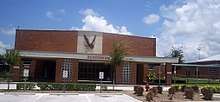 Dunedin High School
Dunedin High School Dunedin Causeway looking west. Honeymoon Island is on the viewer's right.
Dunedin Causeway looking west. Honeymoon Island is on the viewer's right. Sign welcoming visitors to Dunedin on Edgewater Drive
Sign welcoming visitors to Dunedin on Edgewater Drive Band shell in the park in downtown Dunedin
Band shell in the park in downtown Dunedin The Dunedin Public Library
The Dunedin Public Library The Dunedin Garden Club Butterfly Garden at the Dunedin Public Library
The Dunedin Garden Club Butterfly Garden at the Dunedin Public Library The Dunedin Public Library patio
The Dunedin Public Library patio Bandstand at Edgewater Park
Bandstand at Edgewater Park
References
- "2018 U.S. Gazetteer Files". United States Census Bureau. Retrieved Jul 19, 2019.
- "Population and Housing Unit Estimates". Retrieved May 21, 2020.
- "U.S. Census website". United States Census Bureau. Retrieved 2008-01-31.
- "US Board on Geographic Names". United States Geological Survey. 2007-10-25. Retrieved 2008-01-31.
- "Profile of General Population and Housing Characteristics: 2010 Demographic Profile Data (DP-1): Dunedin city, Florida". United States Census Bureau. Retrieved May 4, 2012.
- http://www.tampabay.com/news/article1021783.ece tampabay.com
- "Archived copy". Archived from the original on 2019-02-13. Retrieved 2014-03-03.CS1 maint: archived copy as title (link)
- "US Gazetteer files: 2010, 2000, and 1990". United States Census Bureau. 2011-02-12. Retrieved 2011-04-23.
- "Census of Population and Housing". Census.gov. Retrieved June 4, 2015.
- Helfand, Lorri. "Largo makes Schiller a priority." Clearwater Times (Edition of St. Petersburg Times). Thursday February 23, 2006. Page 1. Retrieved from Google News (83 of 108) on August 28, 2011.
- "Home." Schiller International University. Retrieved on August 28, 2011. "Main Campus 8560 Ulmerton Road Largo, Florida 33771 "
- "Univision sues over Nielsen's meters." Associated Press at the St. Petersburg Times. June 11, 2004. Retrieved on August 28, 2011.
- "A Florida woman was fined $100,000 for a dirty pool and overgrown grass. When do fines become excessive?". Yahoo Finance. 2018-08-26. Retrieved 2019-10-16.
- Berry, Michael (2019-05-14). "Florida Man Faces Foreclosure Due To Big Fines For Uncut Grass". Retrieved 2019-10-16.
- "Chapter 22 - Code Enforcement". Municode Library. Retrieved 2019-10-16.
- http://www.dunedingov.com/index.aspx?page=392
- "Archived copy". Archived from the original on 2008-10-03. Retrieved 2013-11-16.CS1 maint: archived copy as title (link)
- William L. Davidson, Dunedin Thru the Years 1850–1978 (Charlotte, N.C.: Delmar Printing Co., 1978)
- http://www.museumoffloridahistory.com/exhibits/permanent/wwii/panel.cfm?panel=3_6
- https://www.youtube.com/watch?v=xg_PHTYdC-Y
- Wynne, Nick; Moorhead, Richard (2010). Florida in World War II: Floating Fortress. ISBN 9781596299290.
- https://news.google.com/newspapers?nid=888&dat=19440529&id=KKFPAAAAIBAJ&sjid=yE4DAAAAIBAJ&pg=7117,5271099
- https://www.dunedingov.com/city-departments/planning-development/historic-preservation
- "Home." Dunedin Pack 10
- "Home Archived 2012-04-18 at the Wayback Machine." Dunedin Pack 422
- Dunedin: The Home of Honeymoon Island. City commission. (2013).
- "Volunteer Services". City of Dunedin. Archived from the original on 10 June 2012. Retrieved 31 May 2012.
- https://www.dunedingov.com/city-departments/emergency-services/fire-administration
- https://www.dunedingov.com/city-departments/parks-recreation/facilities/community-center
- https://www.dunedingov.com/city-departments/parks-recreation/facilities/hale-senior-activity-center
- "Golf Carts in the City". City of Dunedin. Retrieved August 11, 2018.
- http://www.dunedingov.com/index.aspx?page=151
- http://www.dunedin-fl.com/
- "History of the Library". Dunedin, FL. Retrieved 13 April 2020.
- Morgan, Nancy (2001-09-16). "CFL's Clemons recalls growing up in Dunedin". St. Petersburg Times. Retrieved 2008-10-05.
External links
| Wikivoyage has a travel guide for Dunedin (Florida). |
